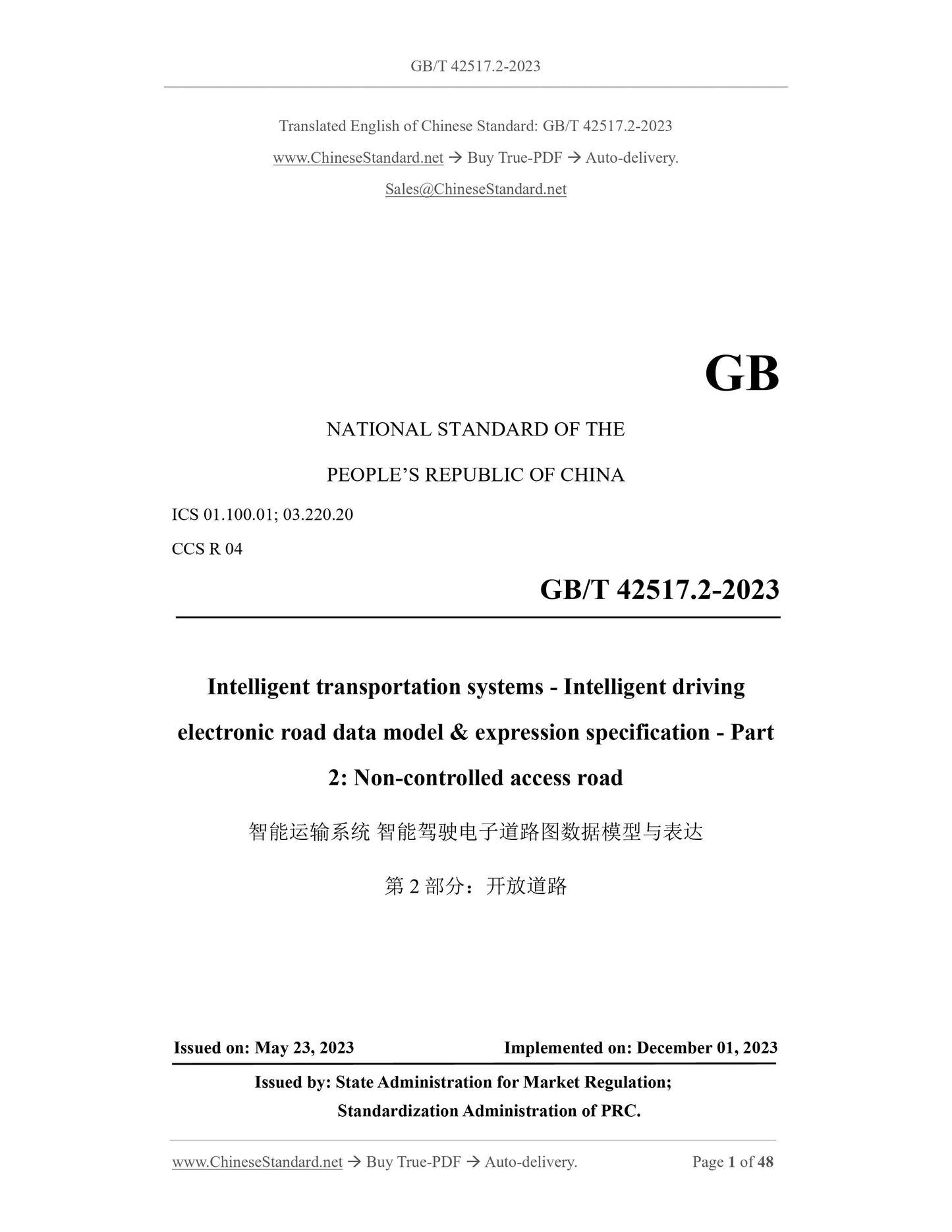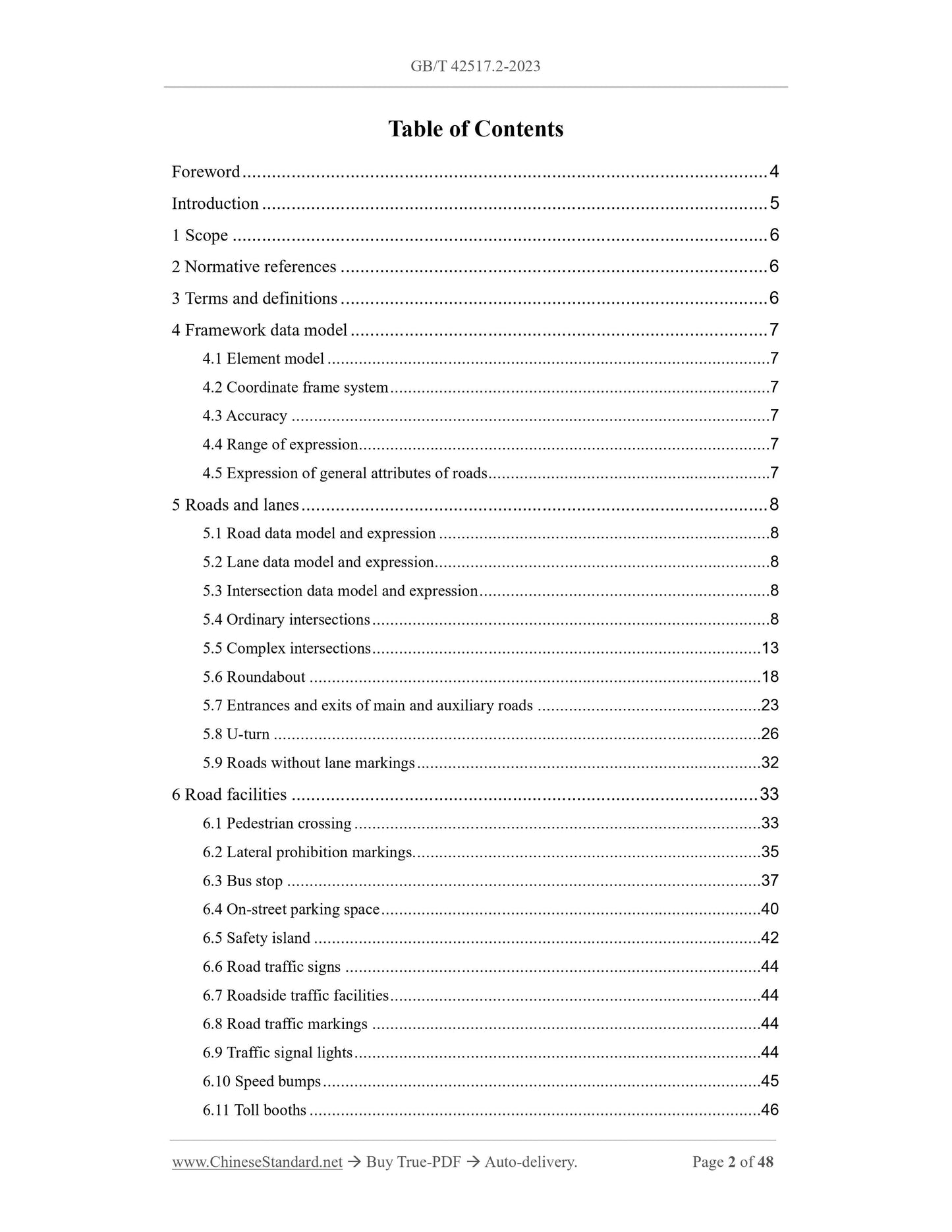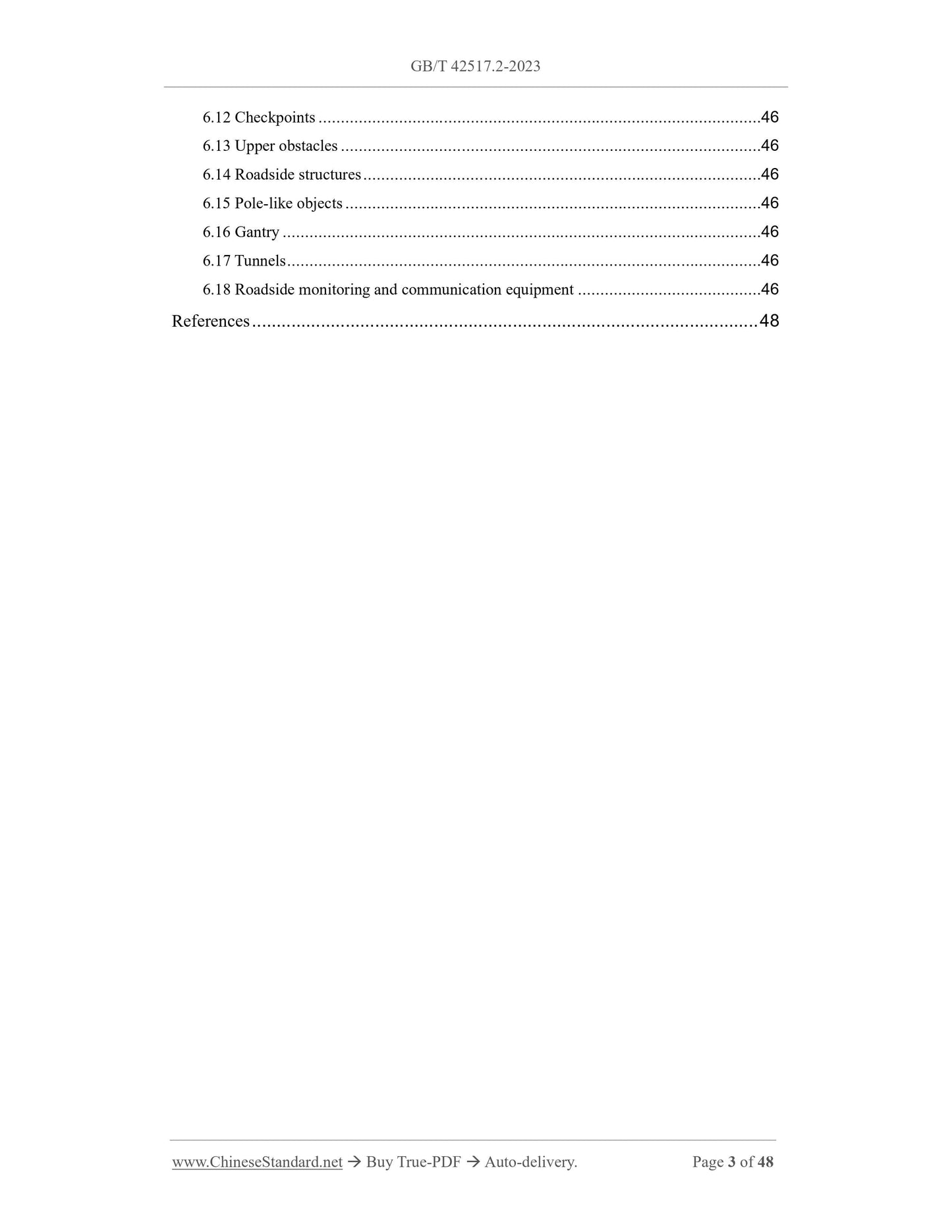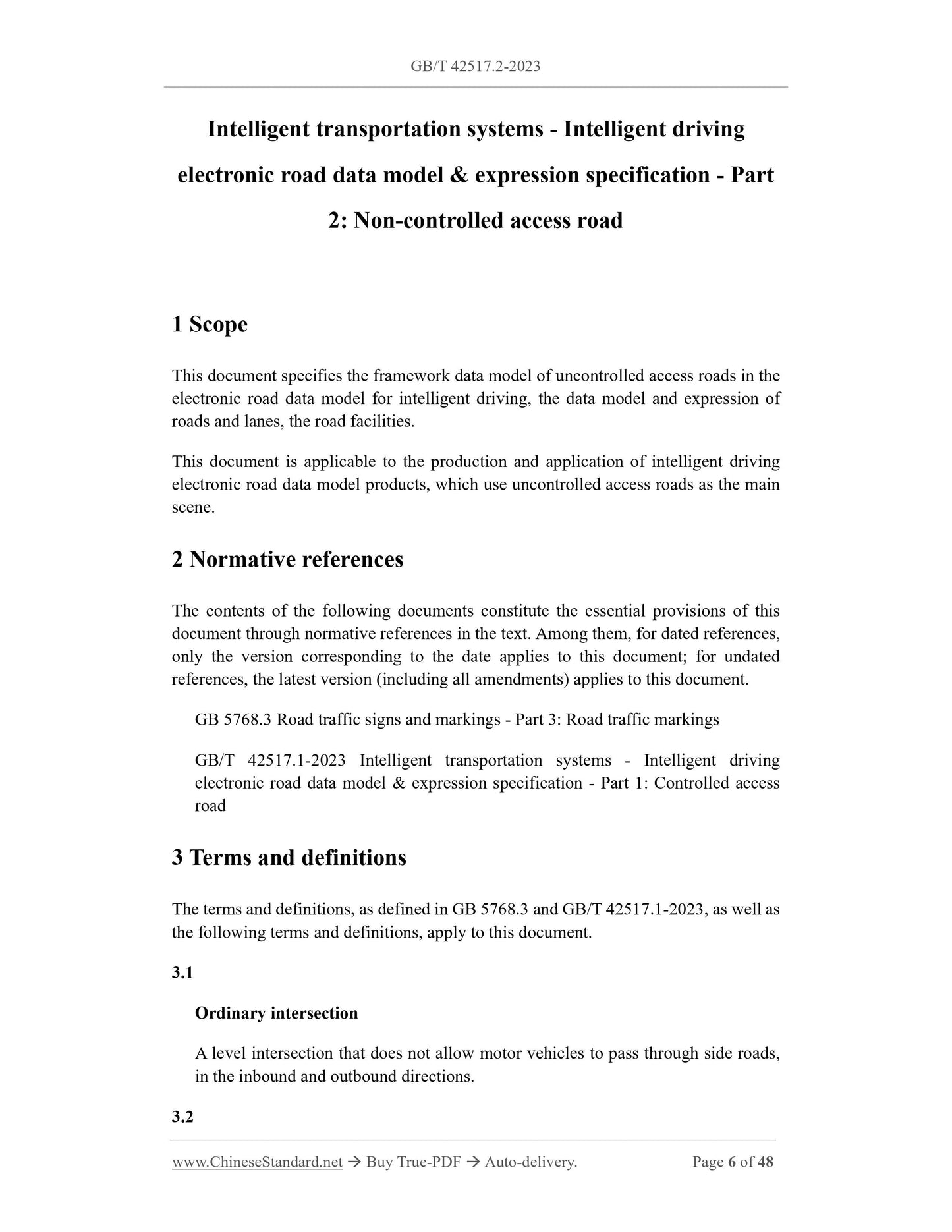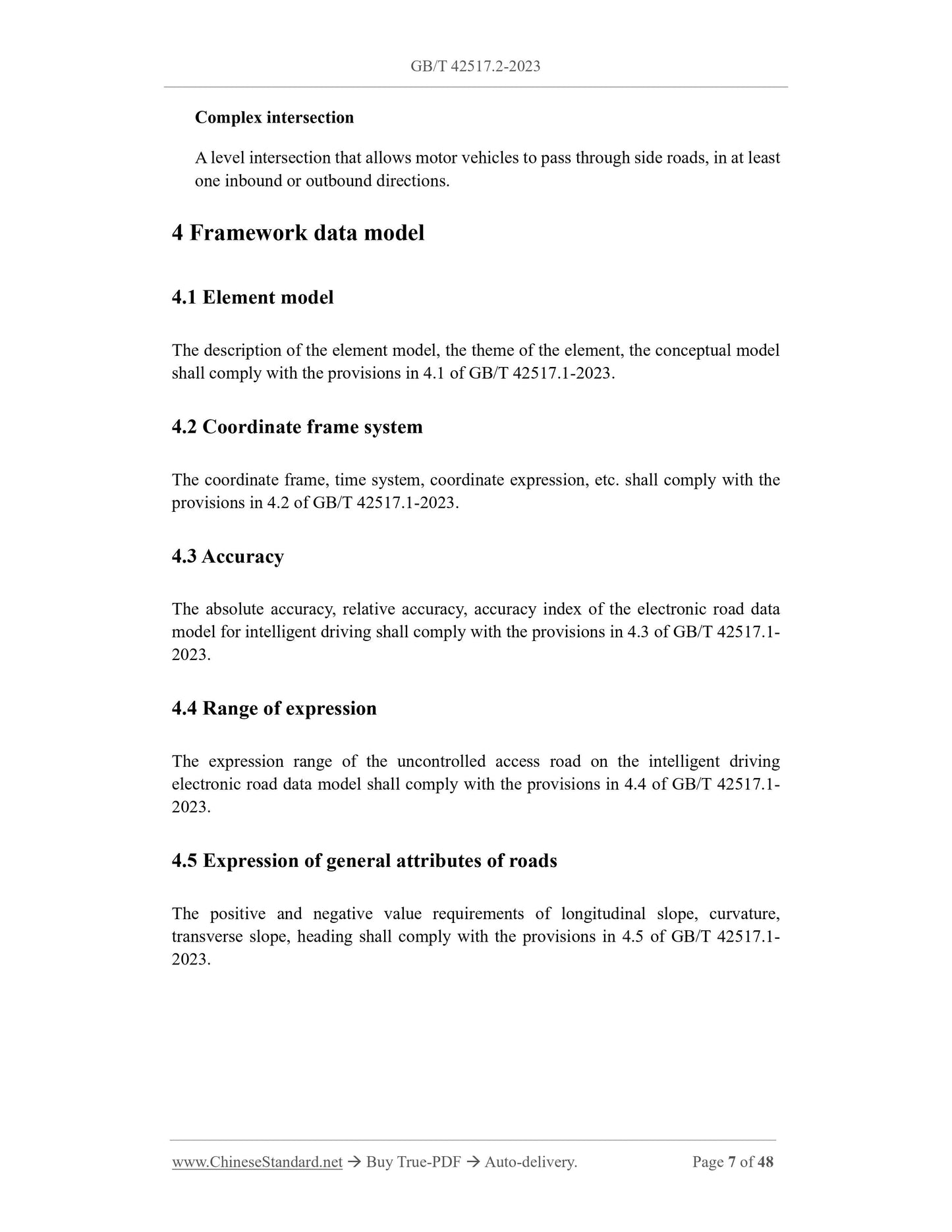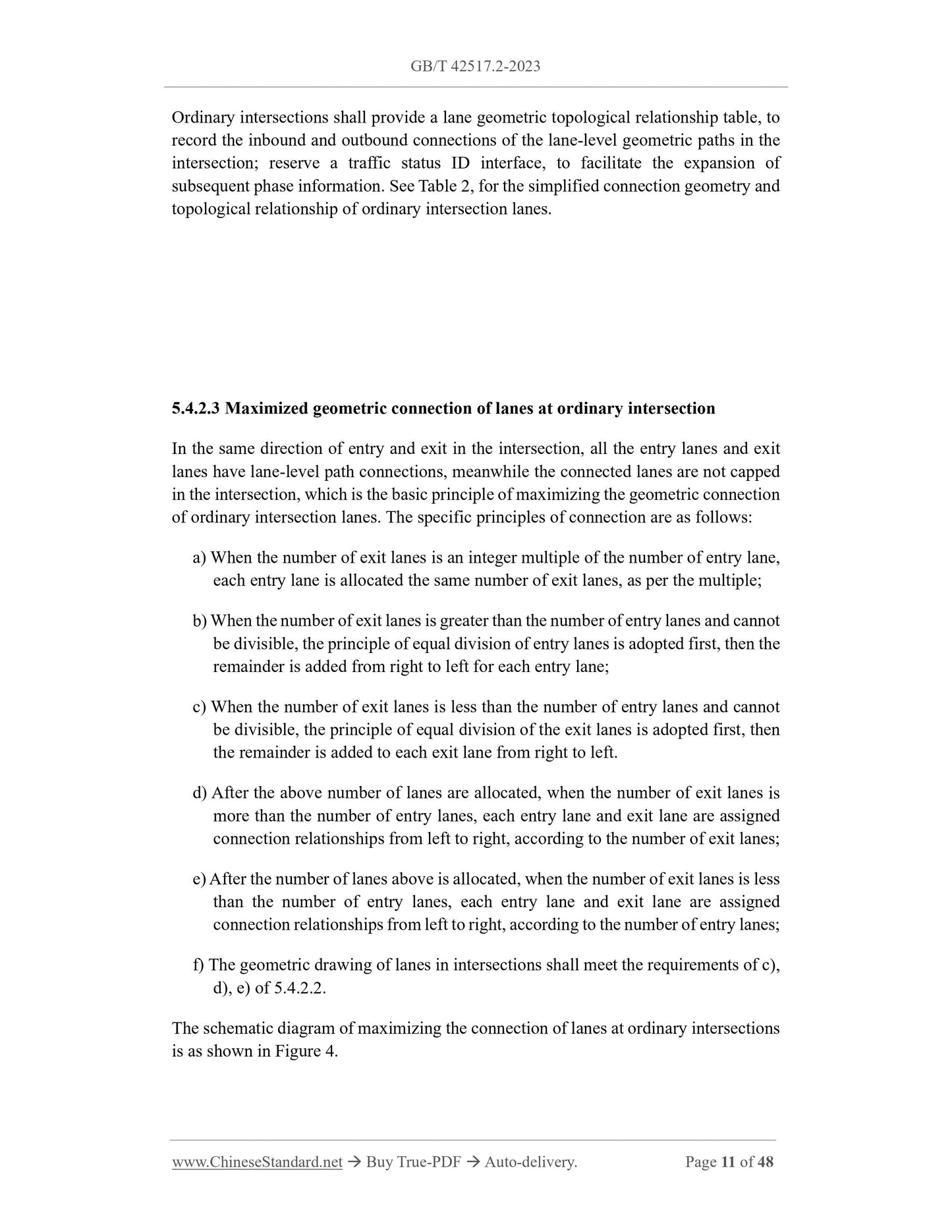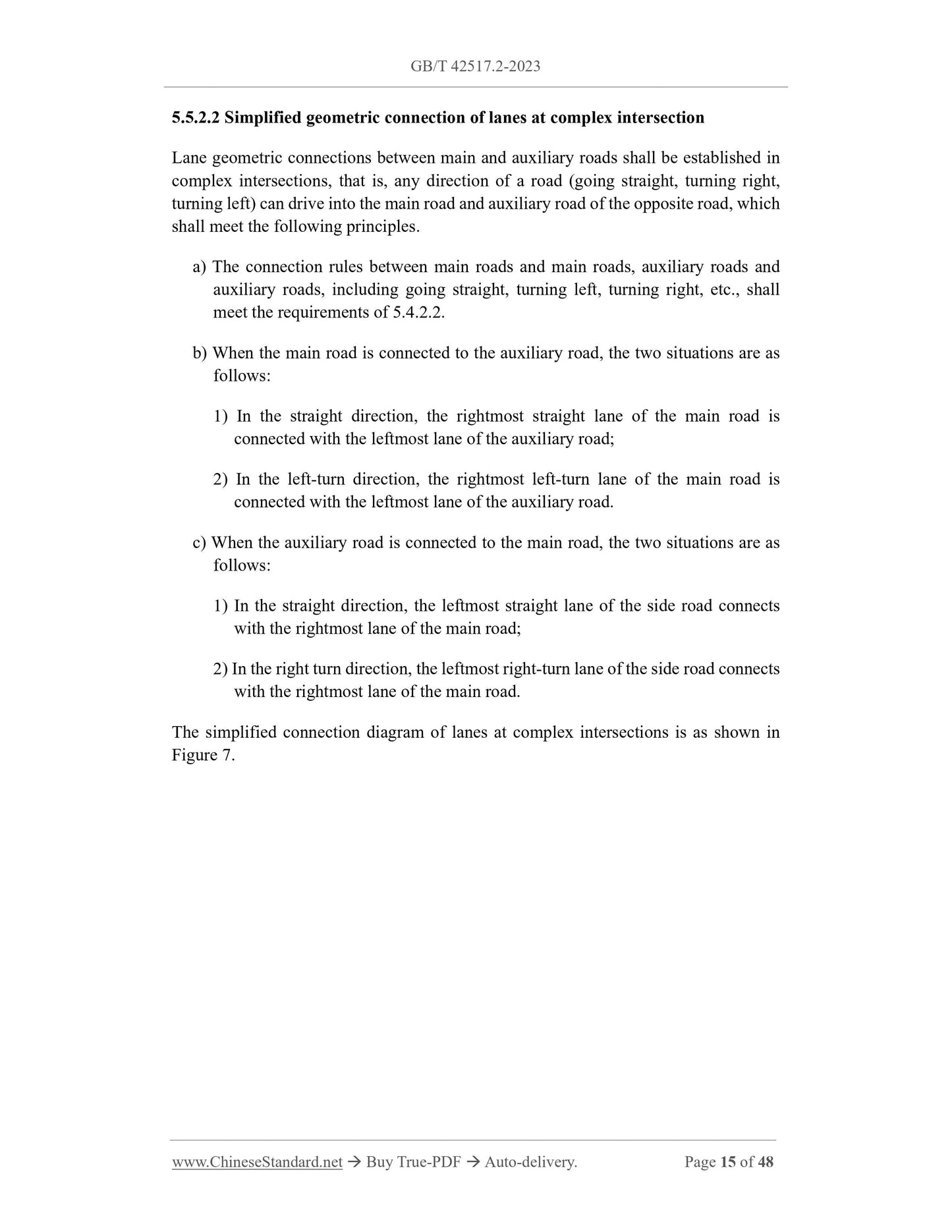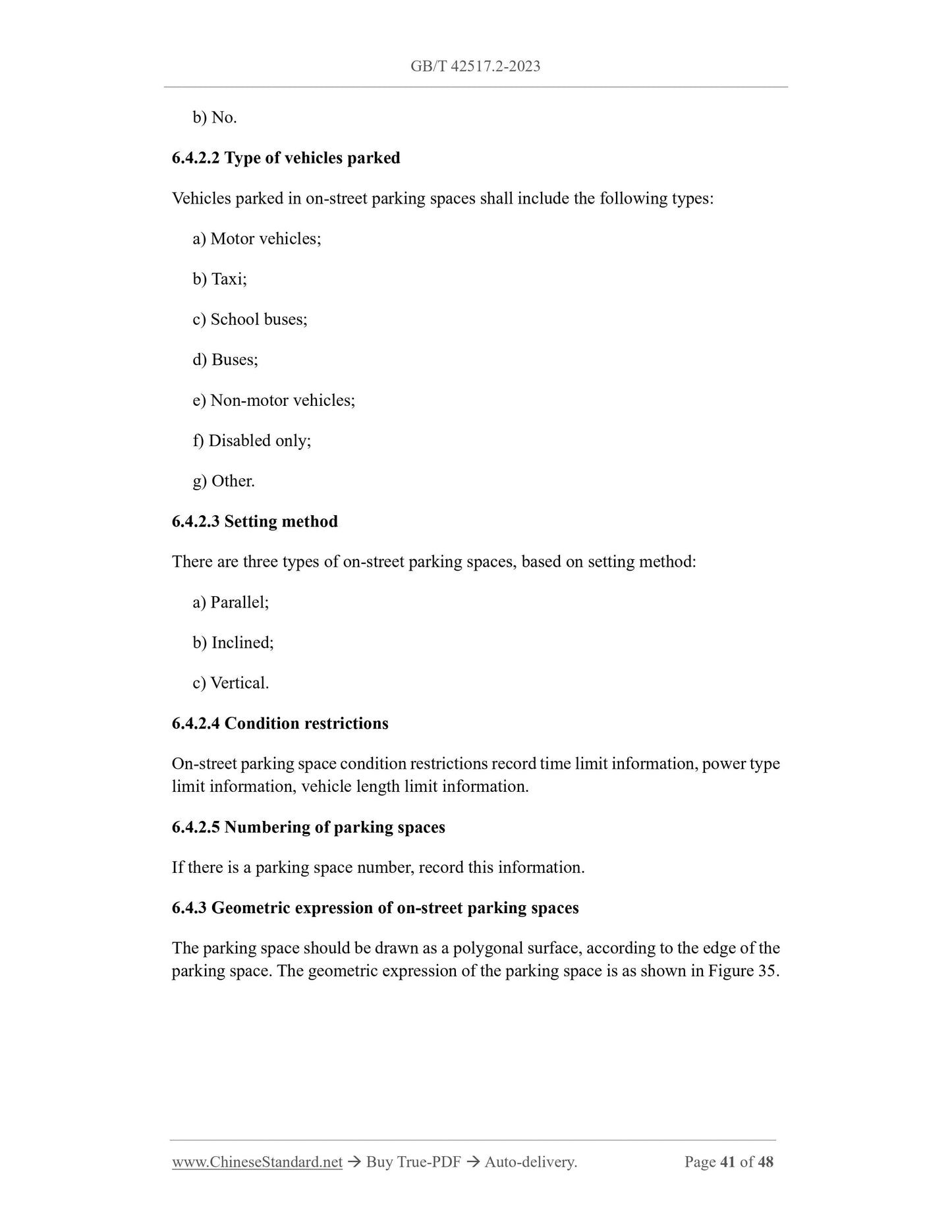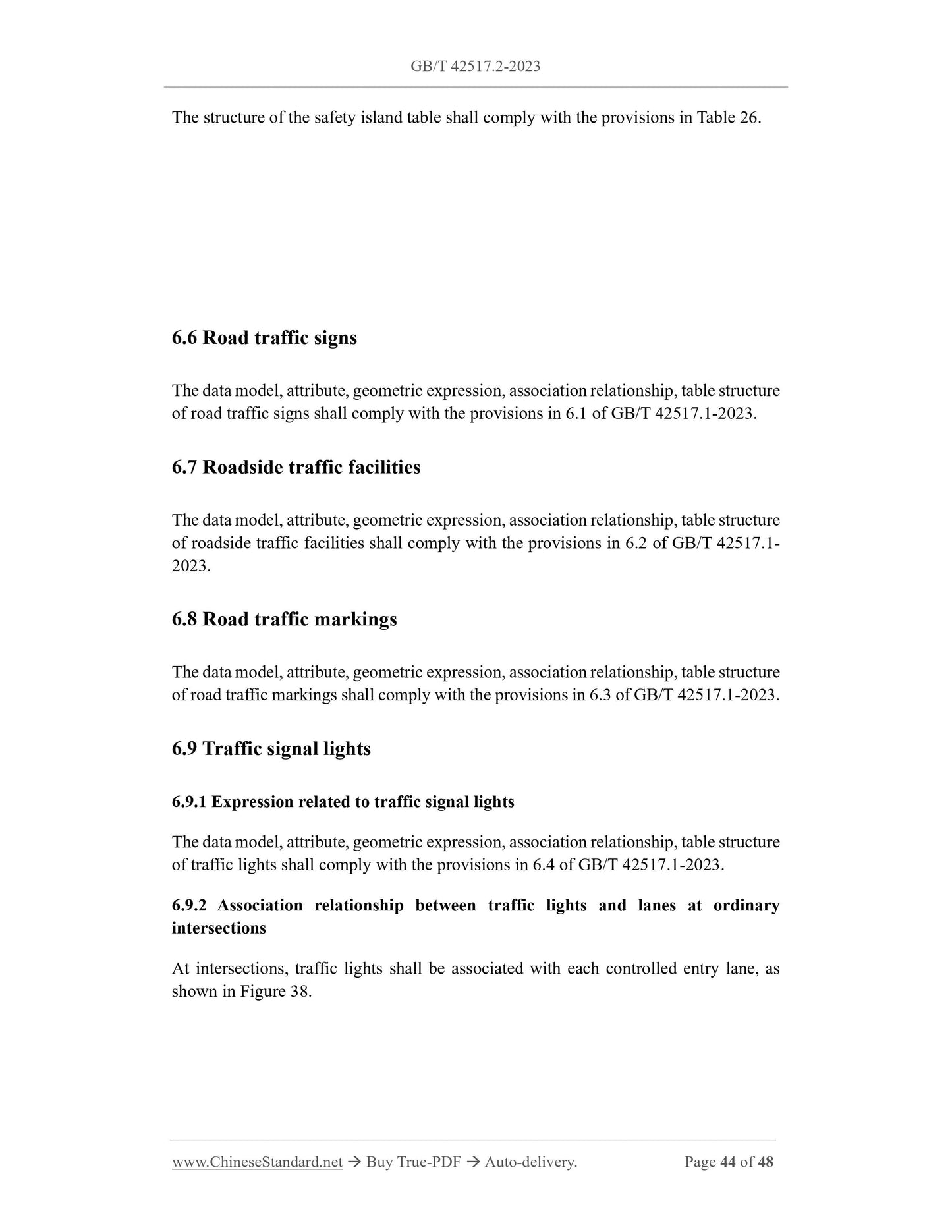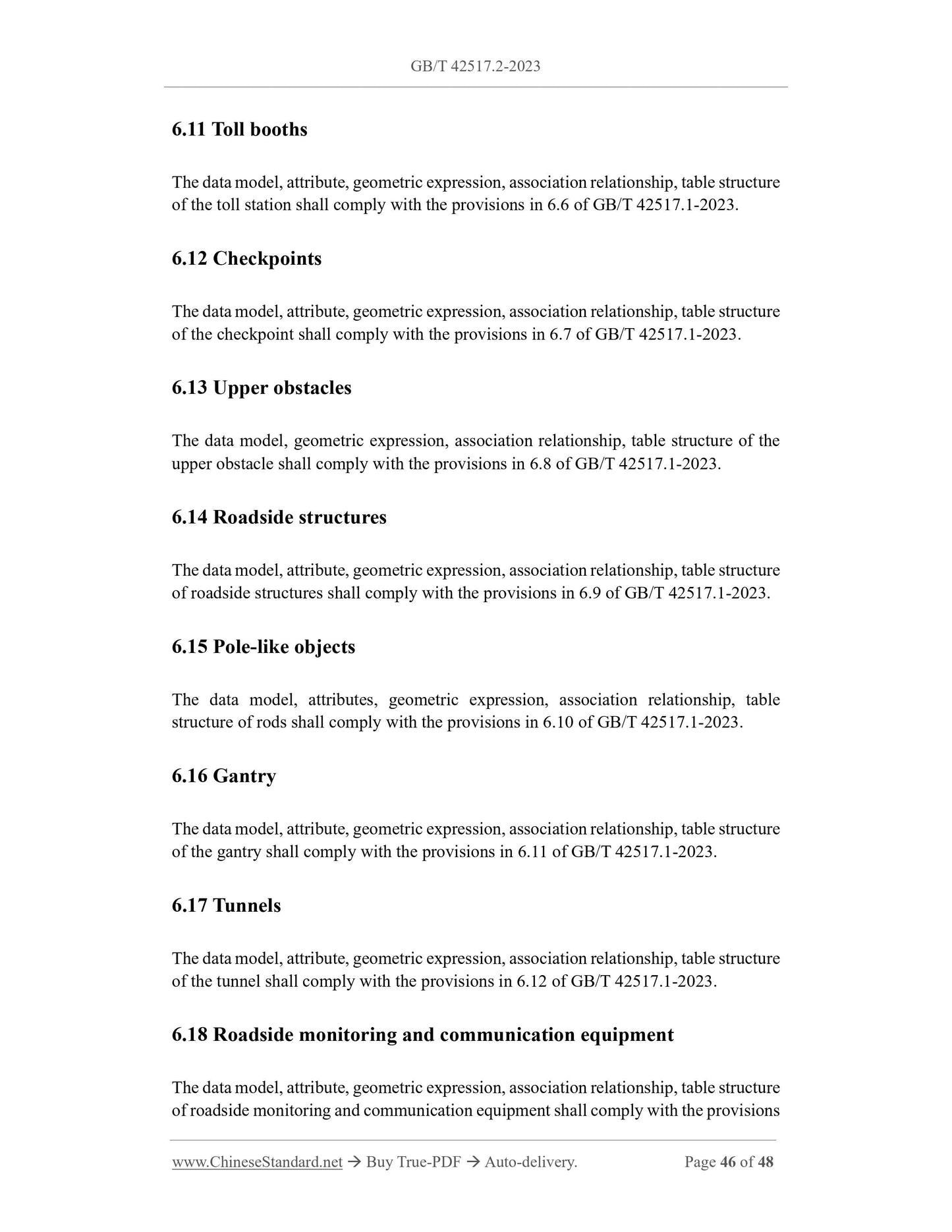1
/
of
10
www.ChineseStandard.us -- Field Test Asia Pte. Ltd.
GB/T 42517.2-2023 English PDF (GB/T42517.2-2023)
GB/T 42517.2-2023 English PDF (GB/T42517.2-2023)
Regular price
$755.00
Regular price
Sale price
$755.00
Unit price
/
per
Shipping calculated at checkout.
Couldn't load pickup availability
GB/T 42517.2-2023: Intelligent transportation systems - Intelligent driving electronic road data model and expression specification - Part 2: Non-controlled access road
Delivery: 9 seconds. Download (& Email) true-PDF + Invoice.
Get Quotation: Click GB/T 42517.2-2023 (Self-service in 1-minute)
Historical versions (Master-website): GB/T 42517.2-2023
Preview True-PDF (Reload/Scroll-down if blank)
GB/T 42517.2-2023
GB
NATIONAL STANDARD OF THE
PEOPLE’S REPUBLIC OF CHINA
ICS 01.100.01; 03.220.20
CCS R 04
Intelligent transportation systems - Intelligent driving
electronic road data model and expression specification - Part
2: Non-controlled access road
ISSUED ON: MAY 23, 2023
IMPLEMENTED ON: DECEMBER 01, 2023
Issued by: State Administration for Market Regulation;
Standardization Administration of PRC.
Table of Contents
Foreword ... 4
Introduction ... 5
1 Scope ... 6
2 Normative references ... 6
3 Terms and definitions ... 6
4 Framework data model ... 7
4.1 Element model ... 7
4.2 Coordinate frame system ... 7
4.3 Accuracy ... 7
4.4 Range of expression ... 7
4.5 Expression of general attributes of roads ... 7
5 Roads and lanes ... 8
5.1 Road data model and expression ... 8
5.2 Lane data model and expression ... 8
5.3 Intersection data model and expression ... 8
5.4 Ordinary intersections ... 8
5.5 Complex intersections ... 13
5.6 Roundabout ... 18
5.7 Entrances and exits of main and auxiliary roads ... 23
5.8 U-turn ... 26
5.9 Roads without lane markings ... 32
6 Road facilities ... 33
6.1 Pedestrian crossing ... 33
6.2 Lateral prohibition markings ... 35
6.3 Bus stop ... 37
6.4 On-street parking space ... 40
6.5 Safety island ... 42
6.6 Road traffic signs ... 44
6.7 Roadside traffic facilities ... 44
6.8 Road traffic markings ... 44
6.9 Traffic signal lights ... 44
6.10 Speed bumps ... 45
6.11 Toll booths ... 46
6.12 Checkpoints ... 46
6.13 Upper obstacles ... 46
6.14 Roadside structures ... 46
6.15 Pole-like objects ... 46
6.16 Gantry ... 46
6.17 Tunnels ... 46
6.18 Roadside monitoring and communication equipment ... 46
References ... 48
Intelligent transportation systems - Intelligent driving
electronic road data model and expression specification - Part
2: Non-controlled access road
1 Scope
This document specifies the framework data model of uncontrolled access roads in the
electronic road data model for intelligent driving, the data model and expression of
roads and lanes, the road facilities.
This document is applicable to the production and application of intelligent driving
electronic road data model products, which use uncontrolled access roads as the main
scene.
2 Normative references
The contents of the following documents constitute the essential provisions of this
document through normative references in the text. Among them, for dated references,
only the version corresponding to the date applies to this document; for undated
references, the latest version (including all amendments) applies to this document.
GB 5768.3 Road traffic signs and markings - Part 3: Road traffic markings
GB/T 42517.1-2023 Intelligent transportation systems - Intelligent driving
electronic road data model and expression specification - Part 1: Controlled access
road
3 Terms and definitions
The terms and definitions, as defined in GB 5768.3 and GB/T 42517.1-2023, as well as
the following terms and definitions, apply to this document.
3.1
Ordinary intersection
A level intersection that does not allow motor vehicles to pass through side roads,
in the inbound and outbound directions.
3.2
Complex intersection
A level intersection that allows motor vehicles to pass through side roads, in at least
one inbound or outbound directions.
4 Framework data model
4.1 Element model
The description of the element model, the theme of the element, the conceptual model
shall comply with the provisions in 4.1 of GB/T 42517.1-2023.
4.2 Coordinate frame system
The coordinate frame, time system, coordinate expression, etc. shall comply with the
provisions in 4.2 of GB/T 42517.1-2023.
4.3 Accuracy
The absolute accuracy, relative accuracy, accuracy index of the electronic road data
model for intelligent driving shall comply with the provisions in 4.3 of GB/T 42517.1-
2023.
4.4 Range of expression
The expression range of the uncontrolled access road on the intelligent driving
electronic road data model shall comply with the provisions in 4.4 of GB/T 42517.1-
2023.
4.5 Expression of general attributes of roads
The positive and negative value requirements of longitudinal slope, curvature,
transverse slope, heading shall comply with the provisions in 4.5 of GB/T 42517.1-
2023.
Ordinary intersections shall provide a lane geometric topological relationship table, to
record the inbound and outbound connections of the lane-level geometric paths in the
intersection; reserve a traffic status ID interface, to facilitate the expansion of
subsequent phase information. See Table 2, for the simplified connection geometry and
topological relationship of ordinary intersection lanes.
5.4.2.3 Maximized geometric connection of lanes at ordinary intersection
In the same direction of entry and exit in the intersection, all the entry lanes and exit
lanes have lane-level path connections, meanwhile the connected lanes are not capped
in the intersection, which is the basic principle of maximizing the geometric connection
of ordinary intersection lanes. The specific principles of connection are as follows:
a) When the number of exit lanes is an integer multiple of the number of entry lane,
each entry lane is allocated the same number of exit lanes, as per the multiple;
b) When the number of exit lanes is greater than the number of entry lanes and cannot
be divisible, the principle of equal division of entry lanes is adopted first, then the
remainder is added from right to left for each entry lane;
c) When the number of exit lanes is less than the number of entry lanes and cannot
be divisible, the principle of equal division of the exit lanes is adopted first, then
the remainder is added to each exit lane from right to left.
d) After the above number of lanes are allocated, when the number of exit lanes is
more than the number of entry lanes, each entry lane and exit lane are assigned
connection relationships from left to right, according to the number of exit lanes;
e) After the number of lanes above is allocated, when the number of exit lanes is less
than the number of entry lanes, each entry lane and exit lane are assigned
connection relationships from left to right, according to the number of entry lanes;
f) The geometric drawing of lanes in intersections shall meet the requirements of c),
d), e) of 5.4.2.2.
The schematic diagram of maximizing the connection of lanes at ordinary intersections
is as shown in Figure 4.
5.5.2.2 Simplified geometric connection of lanes at complex intersection
Lane geometric connections between main and auxiliary roads shall be established in
complex intersections, that is, any direction of a road (going straight, turning right,
turning left) can drive into the main road and auxiliary road of the opposite road, which
shall meet the following principles.
a) The connection rules between main roads and main roads, auxiliary roads and
auxiliary roads, including going straight, turning left, turning right, etc., shall
meet the requirements of 5.4.2.2.
b) When the main road is connected to the auxiliary road, the two situations are as
follows:
1) In the straight direction, the rightmost straight lane of the main road is
connected with the leftmost lane of the auxiliary road;
2) In the left-turn direction, the rightmost left-turn lane of the main road is
connected with the leftmost lane of the auxiliary road.
c) When the auxiliary road is connected to the main road, the two situations are as
follows:
1) In the straight direction, the leftmost straight lane of the side road connects
with the rightmost lane of the main road;
2) In the right turn direction, the leftmost right-turn lane of the side road connects
with the rightmost lane of the main road.
The simplified connection diagram of lanes at complex intersections is as shown in
Figure 7.
b) No.
6.4.2.2 Type of vehicles parked
Vehicles parked in on-street parking spaces shall include the following types:
a) Motor vehicles;
b) Taxi;
c) School buses;
d) Buses;
e) Non-motor vehicles;
f) Disabled only;
g) Other.
6.4.2.3 Setting method
There are three types of on-street parking spaces, based on setting method:
a) Parallel;
b) Inclined;
c) Vertical.
6.4.2.4 Condition restrictions
On-street parking space condition restrictions record time limit information, power type
limit information, vehicle length limit information.
6.4.2.5 Numbering of parking spaces
If there is a parking space number, record this information.
6.4.3 Geometric expression of on-street parking spaces
The parking space should be drawn as a polygonal surface, according to the edge of the
parking space. The geometric expression of the parking space is as shown in Figure 35.
The structure of the safety island table shall comply with the provisions in Table 26.
6.6 Road traffic signs
The data model, attribute, geometric expression, association relationship, table structure
of road traffic signs shall comply with the provisions in 6.1 of GB/T 42517.1-2023.
6.7 Roadside traffic facilities
The data model, attribute, geometric expression, association relationship, table structure
of roadside traffic facilities shall comply with the provisions in 6.2 of GB/T 42517.1-
2023.
6.8 Road traffic markings
The data model, attribute, geometric expression, association relationship, table structure
of road traffic markings shall comply with the provisions in 6.3 of GB/T 42517.1-2023.
6.9 Traffic signal lights
6.9.1 Expression related to traffic signal lights
The data model, attribute, geometric expression, association relationship, table structure
of traffic lights shall comply with the provisions in 6.4 of GB/T 42517.1-2023.
6.9.2 Association relationship between traffic lights and lanes at ordinary
intersections
At intersections, traffic lights shall be associated with each controlled entry lane, as
shown in Figure 38.
6.11 Toll booths
The data model, attribute, geometric expression, association relationship, table structure
of the toll station shall comply with the provisions in 6.6 of GB/T 42517.1-2023.
6.12 Checkpoints
The data model, attribute, geometric expression, association relationship, table structure
of the checkpoint shall comply with the provisions in 6.7 of GB/T 42517.1-2023.
6.13 Upper obstacles
The data model, geometric expression, association relationship, table structure of the
upper obstacle shall comply with the provisions in 6.8 of GB/T 42517.1-2023.
6.14 Roadside structures
The data model, attribute, geometric expression, association relationship, table structure
of roadside structures shall comply with the provisions in 6.9 of GB/T 42517.1-2023.
6.15 Pole-like objects
The data model, attributes, geometric expression, association relationship, table
structure of rods shall comply with the provisions in 6.10 of GB/T 42517.1-2023.
6.16 Gantry
The data model, attribute, geometric expression, association relationship, table structure
of the gantry shall comply with the provisions in 6.11 of GB/T 42517.1-2023.
6.17 Tunnels
The data model, attribute, geometric expression, association relationship, table structure
of the tunnel shall comply with the provisions in 6.12 of GB/T 42517.1-2023.
6.18 Roadside monitoring and communication equipment
The data model, attribute, geometric expression, association relationship, table structure
of roadside monitoring and communication equipment shall comply with the provisions
GB/T 42517.2-2023
GB
NATIONAL STANDARD OF THE
PEOPLE’S REPUBLIC OF CHINA
ICS 01.100.01; 03.220.20
CCS R 04
Intelligent transportation systems - Intelligent driving
electronic road data model and expression specification - Part
2: Non-controlled access road
ISSUED ON: MAY 23, 2023
IMPLEMENTED ON: DECEMBER 01, 2023
Issued by: State Administration for Market Regulation;
Standardization Administration of PRC.
Table of Contents
Foreword ... 4
Introduction ... 5
1 Scope ... 6
2 Normative references ... 6
3 Terms and definitions ... 6
4 Framework data model ... 7
4.1 Element model ... 7
4.2 Coordinate frame system ... 7
4.3 Accuracy ... 7
4.4 Range of expression ... 7
4.5 Expression of general attributes of roads ... 7
5 Roads and lanes ... 8
5.1 Road data model and expression ... 8
5.2 Lane data model and expression ... 8
5.3 Intersection data model and expression ... 8
5.4 Ordinary intersections ... 8
5.5 Complex intersections ... 13
5.6 Roundabout ... 18
5.7 Entrances and exits of main and auxiliary roads ... 23
5.8 U-turn ... 26
5.9 Roads without lane markings ... 32
6 Road facilities ... 33
6.1 Pedestrian crossing ... 33
6.2 Lateral prohibition markings ... 35
6.3 Bus stop ... 37
6.4 On-street parking space ... 40
6.5 Safety island ... 42
6.6 Road traffic signs ... 44
6.7 Roadside traffic facilities ... 44
6.8 Road traffic markings ... 44
6.9 Traffic signal lights ... 44
6.10 Speed bumps ... 45
6.11 Toll booths ... 46
6.12 Checkpoints ... 46
6.13 Upper obstacles ... 46
6.14 Roadside structures ... 46
6.15 Pole-like objects ... 46
6.16 Gantry ... 46
6.17 Tunnels ... 46
6.18 Roadside monitoring and communication equipment ... 46
References ... 48
Intelligent transportation systems - Intelligent driving
electronic road data model and expression specification - Part
2: Non-controlled access road
1 Scope
This document specifies the framework data model of uncontrolled access roads in the
electronic road data model for intelligent driving, the data model and expression of
roads and lanes, the road facilities.
This document is applicable to the production and application of intelligent driving
electronic road data model products, which use uncontrolled access roads as the main
scene.
2 Normative references
The contents of the following documen...
Delivery: 9 seconds. Download (& Email) true-PDF + Invoice.
Get Quotation: Click GB/T 42517.2-2023 (Self-service in 1-minute)
Historical versions (Master-website): GB/T 42517.2-2023
Preview True-PDF (Reload/Scroll-down if blank)
GB/T 42517.2-2023
GB
NATIONAL STANDARD OF THE
PEOPLE’S REPUBLIC OF CHINA
ICS 01.100.01; 03.220.20
CCS R 04
Intelligent transportation systems - Intelligent driving
electronic road data model and expression specification - Part
2: Non-controlled access road
ISSUED ON: MAY 23, 2023
IMPLEMENTED ON: DECEMBER 01, 2023
Issued by: State Administration for Market Regulation;
Standardization Administration of PRC.
Table of Contents
Foreword ... 4
Introduction ... 5
1 Scope ... 6
2 Normative references ... 6
3 Terms and definitions ... 6
4 Framework data model ... 7
4.1 Element model ... 7
4.2 Coordinate frame system ... 7
4.3 Accuracy ... 7
4.4 Range of expression ... 7
4.5 Expression of general attributes of roads ... 7
5 Roads and lanes ... 8
5.1 Road data model and expression ... 8
5.2 Lane data model and expression ... 8
5.3 Intersection data model and expression ... 8
5.4 Ordinary intersections ... 8
5.5 Complex intersections ... 13
5.6 Roundabout ... 18
5.7 Entrances and exits of main and auxiliary roads ... 23
5.8 U-turn ... 26
5.9 Roads without lane markings ... 32
6 Road facilities ... 33
6.1 Pedestrian crossing ... 33
6.2 Lateral prohibition markings ... 35
6.3 Bus stop ... 37
6.4 On-street parking space ... 40
6.5 Safety island ... 42
6.6 Road traffic signs ... 44
6.7 Roadside traffic facilities ... 44
6.8 Road traffic markings ... 44
6.9 Traffic signal lights ... 44
6.10 Speed bumps ... 45
6.11 Toll booths ... 46
6.12 Checkpoints ... 46
6.13 Upper obstacles ... 46
6.14 Roadside structures ... 46
6.15 Pole-like objects ... 46
6.16 Gantry ... 46
6.17 Tunnels ... 46
6.18 Roadside monitoring and communication equipment ... 46
References ... 48
Intelligent transportation systems - Intelligent driving
electronic road data model and expression specification - Part
2: Non-controlled access road
1 Scope
This document specifies the framework data model of uncontrolled access roads in the
electronic road data model for intelligent driving, the data model and expression of
roads and lanes, the road facilities.
This document is applicable to the production and application of intelligent driving
electronic road data model products, which use uncontrolled access roads as the main
scene.
2 Normative references
The contents of the following documents constitute the essential provisions of this
document through normative references in the text. Among them, for dated references,
only the version corresponding to the date applies to this document; for undated
references, the latest version (including all amendments) applies to this document.
GB 5768.3 Road traffic signs and markings - Part 3: Road traffic markings
GB/T 42517.1-2023 Intelligent transportation systems - Intelligent driving
electronic road data model and expression specification - Part 1: Controlled access
road
3 Terms and definitions
The terms and definitions, as defined in GB 5768.3 and GB/T 42517.1-2023, as well as
the following terms and definitions, apply to this document.
3.1
Ordinary intersection
A level intersection that does not allow motor vehicles to pass through side roads,
in the inbound and outbound directions.
3.2
Complex intersection
A level intersection that allows motor vehicles to pass through side roads, in at least
one inbound or outbound directions.
4 Framework data model
4.1 Element model
The description of the element model, the theme of the element, the conceptual model
shall comply with the provisions in 4.1 of GB/T 42517.1-2023.
4.2 Coordinate frame system
The coordinate frame, time system, coordinate expression, etc. shall comply with the
provisions in 4.2 of GB/T 42517.1-2023.
4.3 Accuracy
The absolute accuracy, relative accuracy, accuracy index of the electronic road data
model for intelligent driving shall comply with the provisions in 4.3 of GB/T 42517.1-
2023.
4.4 Range of expression
The expression range of the uncontrolled access road on the intelligent driving
electronic road data model shall comply with the provisions in 4.4 of GB/T 42517.1-
2023.
4.5 Expression of general attributes of roads
The positive and negative value requirements of longitudinal slope, curvature,
transverse slope, heading shall comply with the provisions in 4.5 of GB/T 42517.1-
2023.
Ordinary intersections shall provide a lane geometric topological relationship table, to
record the inbound and outbound connections of the lane-level geometric paths in the
intersection; reserve a traffic status ID interface, to facilitate the expansion of
subsequent phase information. See Table 2, for the simplified connection geometry and
topological relationship of ordinary intersection lanes.
5.4.2.3 Maximized geometric connection of lanes at ordinary intersection
In the same direction of entry and exit in the intersection, all the entry lanes and exit
lanes have lane-level path connections, meanwhile the connected lanes are not capped
in the intersection, which is the basic principle of maximizing the geometric connection
of ordinary intersection lanes. The specific principles of connection are as follows:
a) When the number of exit lanes is an integer multiple of the number of entry lane,
each entry lane is allocated the same number of exit lanes, as per the multiple;
b) When the number of exit lanes is greater than the number of entry lanes and cannot
be divisible, the principle of equal division of entry lanes is adopted first, then the
remainder is added from right to left for each entry lane;
c) When the number of exit lanes is less than the number of entry lanes and cannot
be divisible, the principle of equal division of the exit lanes is adopted first, then
the remainder is added to each exit lane from right to left.
d) After the above number of lanes are allocated, when the number of exit lanes is
more than the number of entry lanes, each entry lane and exit lane are assigned
connection relationships from left to right, according to the number of exit lanes;
e) After the number of lanes above is allocated, when the number of exit lanes is less
than the number of entry lanes, each entry lane and exit lane are assigned
connection relationships from left to right, according to the number of entry lanes;
f) The geometric drawing of lanes in intersections shall meet the requirements of c),
d), e) of 5.4.2.2.
The schematic diagram of maximizing the connection of lanes at ordinary intersections
is as shown in Figure 4.
5.5.2.2 Simplified geometric connection of lanes at complex intersection
Lane geometric connections between main and auxiliary roads shall be established in
complex intersections, that is, any direction of a road (going straight, turning right,
turning left) can drive into the main road and auxiliary road of the opposite road, which
shall meet the following principles.
a) The connection rules between main roads and main roads, auxiliary roads and
auxiliary roads, including going straight, turning left, turning right, etc., shall
meet the requirements of 5.4.2.2.
b) When the main road is connected to the auxiliary road, the two situations are as
follows:
1) In the straight direction, the rightmost straight lane of the main road is
connected with the leftmost lane of the auxiliary road;
2) In the left-turn direction, the rightmost left-turn lane of the main road is
connected with the leftmost lane of the auxiliary road.
c) When the auxiliary road is connected to the main road, the two situations are as
follows:
1) In the straight direction, the leftmost straight lane of the side road connects
with the rightmost lane of the main road;
2) In the right turn direction, the leftmost right-turn lane of the side road connects
with the rightmost lane of the main road.
The simplified connection diagram of lanes at complex intersections is as shown in
Figure 7.
b) No.
6.4.2.2 Type of vehicles parked
Vehicles parked in on-street parking spaces shall include the following types:
a) Motor vehicles;
b) Taxi;
c) School buses;
d) Buses;
e) Non-motor vehicles;
f) Disabled only;
g) Other.
6.4.2.3 Setting method
There are three types of on-street parking spaces, based on setting method:
a) Parallel;
b) Inclined;
c) Vertical.
6.4.2.4 Condition restrictions
On-street parking space condition restrictions record time limit information, power type
limit information, vehicle length limit information.
6.4.2.5 Numbering of parking spaces
If there is a parking space number, record this information.
6.4.3 Geometric expression of on-street parking spaces
The parking space should be drawn as a polygonal surface, according to the edge of the
parking space. The geometric expression of the parking space is as shown in Figure 35.
The structure of the safety island table shall comply with the provisions in Table 26.
6.6 Road traffic signs
The data model, attribute, geometric expression, association relationship, table structure
of road traffic signs shall comply with the provisions in 6.1 of GB/T 42517.1-2023.
6.7 Roadside traffic facilities
The data model, attribute, geometric expression, association relationship, table structure
of roadside traffic facilities shall comply with the provisions in 6.2 of GB/T 42517.1-
2023.
6.8 Road traffic markings
The data model, attribute, geometric expression, association relationship, table structure
of road traffic markings shall comply with the provisions in 6.3 of GB/T 42517.1-2023.
6.9 Traffic signal lights
6.9.1 Expression related to traffic signal lights
The data model, attribute, geometric expression, association relationship, table structure
of traffic lights shall comply with the provisions in 6.4 of GB/T 42517.1-2023.
6.9.2 Association relationship between traffic lights and lanes at ordinary
intersections
At intersections, traffic lights shall be associated with each controlled entry lane, as
shown in Figure 38.
6.11 Toll booths
The data model, attribute, geometric expression, association relationship, table structure
of the toll station shall comply with the provisions in 6.6 of GB/T 42517.1-2023.
6.12 Checkpoints
The data model, attribute, geometric expression, association relationship, table structure
of the checkpoint shall comply with the provisions in 6.7 of GB/T 42517.1-2023.
6.13 Upper obstacles
The data model, geometric expression, association relationship, table structure of the
upper obstacle shall comply with the provisions in 6.8 of GB/T 42517.1-2023.
6.14 Roadside structures
The data model, attribute, geometric expression, association relationship, table structure
of roadside structures shall comply with the provisions in 6.9 of GB/T 42517.1-2023.
6.15 Pole-like objects
The data model, attributes, geometric expression, association relationship, table
structure of rods shall comply with the provisions in 6.10 of GB/T 42517.1-2023.
6.16 Gantry
The data model, attribute, geometric expression, association relationship, table structure
of the gantry shall comply with the provisions in 6.11 of GB/T 42517.1-2023.
6.17 Tunnels
The data model, attribute, geometric expression, association relationship, table structure
of the tunnel shall comply with the provisions in 6.12 of GB/T 42517.1-2023.
6.18 Roadside monitoring and communication equipment
The data model, attribute, geometric expression, association relationship, table structure
of roadside monitoring and communication equipment shall comply with the provisions
GB/T 42517.2-2023
GB
NATIONAL STANDARD OF THE
PEOPLE’S REPUBLIC OF CHINA
ICS 01.100.01; 03.220.20
CCS R 04
Intelligent transportation systems - Intelligent driving
electronic road data model and expression specification - Part
2: Non-controlled access road
ISSUED ON: MAY 23, 2023
IMPLEMENTED ON: DECEMBER 01, 2023
Issued by: State Administration for Market Regulation;
Standardization Administration of PRC.
Table of Contents
Foreword ... 4
Introduction ... 5
1 Scope ... 6
2 Normative references ... 6
3 Terms and definitions ... 6
4 Framework data model ... 7
4.1 Element model ... 7
4.2 Coordinate frame system ... 7
4.3 Accuracy ... 7
4.4 Range of expression ... 7
4.5 Expression of general attributes of roads ... 7
5 Roads and lanes ... 8
5.1 Road data model and expression ... 8
5.2 Lane data model and expression ... 8
5.3 Intersection data model and expression ... 8
5.4 Ordinary intersections ... 8
5.5 Complex intersections ... 13
5.6 Roundabout ... 18
5.7 Entrances and exits of main and auxiliary roads ... 23
5.8 U-turn ... 26
5.9 Roads without lane markings ... 32
6 Road facilities ... 33
6.1 Pedestrian crossing ... 33
6.2 Lateral prohibition markings ... 35
6.3 Bus stop ... 37
6.4 On-street parking space ... 40
6.5 Safety island ... 42
6.6 Road traffic signs ... 44
6.7 Roadside traffic facilities ... 44
6.8 Road traffic markings ... 44
6.9 Traffic signal lights ... 44
6.10 Speed bumps ... 45
6.11 Toll booths ... 46
6.12 Checkpoints ... 46
6.13 Upper obstacles ... 46
6.14 Roadside structures ... 46
6.15 Pole-like objects ... 46
6.16 Gantry ... 46
6.17 Tunnels ... 46
6.18 Roadside monitoring and communication equipment ... 46
References ... 48
Intelligent transportation systems - Intelligent driving
electronic road data model and expression specification - Part
2: Non-controlled access road
1 Scope
This document specifies the framework data model of uncontrolled access roads in the
electronic road data model for intelligent driving, the data model and expression of
roads and lanes, the road facilities.
This document is applicable to the production and application of intelligent driving
electronic road data model products, which use uncontrolled access roads as the main
scene.
2 Normative references
The contents of the following documen...
Share
